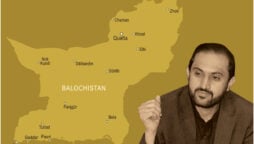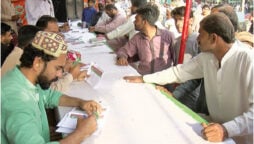
The province takes lead in use of latest technology to preserve and manage water for agriculture use
As a water crisis looms large over the world and Pakistan faces the threat of a drought, Khyber Pakhtunkhwa (KP) takes lead in the use of latest technology to preserve and manage water for agriculture – measures that may turn the province into the granary of Pakistan and the region.
The KP has recently installed the latest automated telemetry sensor system at its 11 canals. Besides improving water governance and management, this system has started to enhance farmer’s income while also contributing to socioeconomic and political stability.
The province has also managed to irrigate more land in recent years and converted 650,000 acres of wasteland into farms alone along the Gomal Zam Command Area. The Gomal Zam Dam now irrigates about 191,000 acres of land.
The Gomal Zam Dam is the third largest water reservoir of the KP after Tarbella and Mangla dams. This dam and other smaller water reservoirs that are planned to be built in its vicinity have the potential of irrigating about one million acres of land.
Experts believe that these dams will not only make the province self-sufficient in food but can also turn it into a granary for Pakistan and the region. These dams may also help the KP cope with challenges like climate change and drought.
An improved water management – besides ensuring food security and converting the barren lands into farms – is helping in controlling floods and preserving water. It will ultimately lead to improve the livelihood of farmers and ensure socio-economic growth of the province. The KP embarked on water resource management and preservation strategy with the support of the USAID, and technical assistance of the International Water Management Institute (IWMI) under the Water Management for Enhanced Productivity (WMfEP) activity.
Besides installation of telemetry systems at almost all the main canals of the province to monitor the flows, the KP also introduced digital warabandi and chakbandi which are key to retain water for useful means; stop its waste and ensure its just distribution among farmers. Warabandi is a system of rotation of supply of water according to a predetermined schedule as per area and crop needs. It specifies the day, time and duration of supply to each holding to ensure equitable water distribution among farmers of an outlet command
Chakbandi means the entire process of collection of data for working out details of gross commanded and cultivable commanded areas of channels as a whole or of individual outlets for working out the chak boundary. Chak boundary is the boundary of areas reserved for irrigation from any particular outlet.
Solar powered drip irrigation systems, raised bed plantations for better water productivity and crop yield, training on crop production and livestock and improved water management and governance are ultimately leading to conversion of wasteland into fields. These steps are likely to enhance crop production besides opening ways to convert millions of acres of wasteland into farms only in Tank and DI Khan districts.
Besides improved water governance, these ventures are considered key to sustain investments – which have already been made as well as those in the pipeline – and ensure that these investments deliver the intended socio-economic and environmental outcomes.
Dr Azeem Shah, from the IWMI said the institute with the support of USAID is helping the KP to improve its capacity for water governance. “A key intervention is [installation of] the Indus Telemetry System at almost all the main canals of the KP to monitor the flows automatically through state of the art instrumentation. “We are automating the inspection of the maintenance and repair works of the irrigation department and introducing digital warabandi/chakbandi for better management of the water resources.
“We are also helping the KP government to implement the KP Water Act 2020 through the operationalization of the Water Resources Regulatory Authority, providing technical and managerial trainings to officials of the KP government at state-of-the-art facilities of LUMS University and carrying out scientific studies to inform better decision-making for the water resource governance of the KP.”
Dr Shah said the Water Management for Enhanced Productivity project will ultimately result in improved livelihoods of farmers and socio-economic growth of the province.
“We focus on the command area of the Gomal Zam Dam where about 191,000 acres of land has been irrigated. Water governance interventions will also benefit all people as water is a shared resource.”
Dr Shah said the IWMI is also building the capacity of the youth and women of the conservative areas of Tank, Kolachi and DIK which fall in the command area of the Gomal Zam Dam so that they may independently manage their kitchen gardens.
“[This is possible through] solar powered drip irrigation systems financed through the project, better livestock management skills to get better yield and better crop production techniques which are needed to ensure food security and water preservation for the future generations.”
WMfEP activity works with a wide range of stakeholders – including public sector organizations, Federal Ministry of Water Resources, the KP Irrigation and Agriculture Department, academia, from the Gomal University and LUMs – and water user associations of Gomal Zam command area in Tank and DI Khan.
The overall target beneficiaries are the farmers and general population of the KP who would benefit from improved water governance and management of the water resources and improved collaboration between Afghanistan and Pakistan water professionals on trans-boundary waters. WMfEP is designed to support operationalization of the Gomal Zam Dam Command Area, improve capacity of government agencies in planning, design and implementation of water resources development and strengthen agricultural water management and governance. It also seeks to increase Afghan-Pakistan collaboration on water policy, practices, and water sector challenges common to each other. It has provided material support to the KP for watershed management in the catchment area of the Gomal Zam Dam to address some of the environment/sediment issues within its Irrigation system.
Gomal Zam Command Area Project Manager Engineer Muhammad Zubair said chukbandi and warabandi have also helped them in judicious distribution of water.
“Plantation of more than 45,000 trees along the barrage and command area over almost 35 kilometers has helped in controlling sedimentation and silting and land erosion which help improve the dam life.”
Zubair said the initiative has helped the KP in controlling floods and sending early warning messages, besides ensuring judicious water distribution and bringing barren land under cultivation.
“The command area and the subsequent canal network is benefiting the Tank and Kulachi area of DI Khan which are at an important geographical point, connecting to Southern Punjab and North and South Waziristan districts on one side and to neighboring Afghanistan on the other. “Thus it can serve as a huge granary for the future and a source of supply not only for the KP and Punjab but also for neighboring Afghanistan,” he said.
Zubair said the Gomal Zam Command Area Development Project will change the destiny of the region, including the adjoining tribal areas, as there are more such areas like Sheikh Haider Zam, Daraban Zam and Tank Zam where such initiatives can be replicated. “Such initiatives are likely to benefit more than 150,000 acres of land. These measures will also boost socioeconomic activity in the region, creating job opportunities besides enhancing agriculture produce and fighting climate change and environmental hazards,” he added.
To a query about future projects in the region, he said the KP government has approved the Chashma Right Bank Canal Project (Lift cum Gravity) near Paizu which is likely to irrigate 288,000 acres of land. The Kurram Tangi-1 has 16,000-acre potential but the Kurram Tangi-2, when built, will cover 350,000 acres of land in Lakki Marwat, Bannu, Karak and North Waziristan.
“All these initiatives if realized and made workable could help irrigate one million acre of land but we are relying more on the success of the Gomal Zam Command Area Project as it will open ways for the rest of the potential projects and will work as a catalyst for the future projects.”
The trickle-down effects and benefits of the project have also started reaching the locals as the farming community as well the women farmers trained in modern farming techniques, drip irrigation, livestock rearing and water governance are benefiting from it a lot.
Gulmeer Khan, a local farmer from Kulachi, said the farming community is very happy as water has now started reaching them. He said earlier water supply was uneven because of poor canal system, water losses and tribal rivalries and feuds.
“We have sufficient water for irrigation as water is properly managed now. Rice and sugarcane crops are not allowed to be grown in the command area due to technical reason; still fields are always seen filled with water which is a good sign for the farming community,” Gulmeer added
He said the situation is getting better but there is a constant need for proper warabandi and cementing of the water channels and distributaries to stop water losses as a lot of water flowing through mud channels is lost and land at the end of canals often become barren due to scarcity of water.”
“There is severe water scarcity in our village and I always needed water for my kitchen garden, learning drip irrigation and its implementation has helped me a lot in watering my plants and getting healthy crops,” said Mer Janey, a female farmer from Landar Baddar, Tehsil Kulachi, in DI Khan district.
Janey, who got training in the latest farming techniques and use of drip irrigation, said this time her plants didn’t dry up and lasted longer. “I grew spinach, radish and carrots in abundance. I even distributed spinach and chilies among all our relatives. Even some passersby bought it from our field.”
Farzana Gul of village Gara Mohbat is another beneficiary of the “Water Management for Enhanced Productivity,” initiative. She said, “I have learned seed sowing techniques along with drip farming and my vegetable crop was excellent this year.”
According to Farzana, natural fertilizer made from household waste and animal waste also helped the women farmers increase their produce. “It is good we have a source of income now,” she added.
A local social activist, Noshheen Bibi, who is helping out the women from both Saraiki and Pashtun tribes in Tank and Kulachi, talked about the difficulties being faced in motivating women and their families to learn modern techniques.
“It is a tribal society and it is very difficult to bring out women but due to our hard work, more and more women are willing to come out and learn the latest farming techniques.” She said there has been a water shortage in the area and farming techniques are conventional. “So we are teaching them about water management, modern techniques of sowing and preservation of vegetable and other farm produce. This training will help women farmers get economically stable and self-sufficient.”
Khatoon Nisa of Kot Atal Sharif in DI Khan said, “I can now preserve my vegetables; even send them to my relatives in Peshawar and Islamabad. In the next season, I am expecting a bumper crop as water is now sufficient and the land texture is according to the need. I am confident I will earn well.”
Catch all the National Nerve News, Breaking News Event and Latest News Updates on The BOL News
Download The BOL News App to get the Daily News Update & Live News.












 Read the complete story text.
Read the complete story text. Listen to audio of the story.
Listen to audio of the story.